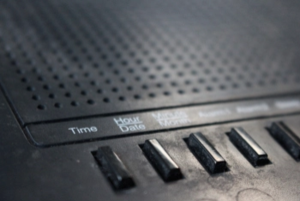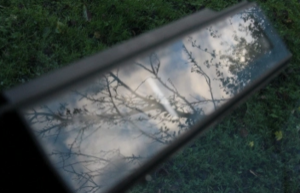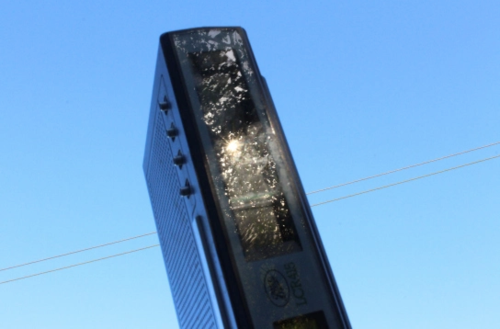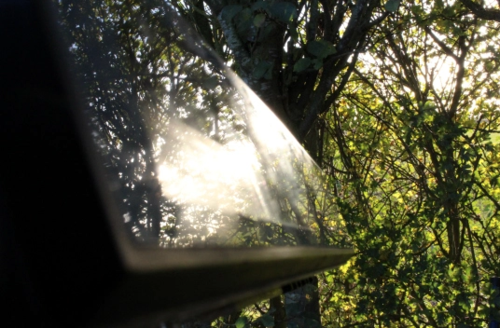My Mother’s old alarm clock radio…
……..as I took photographs of this as a record of its original state before painting over it in order to transform it into a different sort of object, the process took on a life of its own.
At certain angles it reflected the trees and sky outside my studio leading me to think about the different approaches we’ve had to marking time. The sun reflecting on it reminded me of sundials and stonehenge. It reminded me that my Mum no longer has a use for a clock. I imagine time is no longer a limitation or measure for her, as wherever she is, I’m pretty certain she is free from the constraints of time. Us humans have created measures for ourselves as a way to organise our lives, originally in harmony with nature – night and day, as measured by the length of time it takes for the earth to travel around the sun. But we can become slaves to it as well. We watch the minutes tick by, the hours, weeks and years. We are painfully aware of the passing of time and the inevitable journey towards death. How can we learn to perceive time differently? Can we live contently within its limitations. We set alarms, fill our calendars, make plans, talk about living life to the full, carpe diem, try to live in the moment. We reminisce about the past and take plenty of photos to ‘capture’ a moment and preserve a memory.
In the west, we work all hours and appear to be in a constant panic that there is never enough time and we are not masters of our own. We scurry about, trying to find a purpose for the unknown measure we have been given. Why are we so frightened to stop still? What are we afraid of facing? I sometimes wonder why we’re always either planning ahead or reflecting upon the past and rarely noticing where we are right NOW.
It strikes me that the passing of time is inevitable. The world keeps on gently rotating. It’s also true that the faster we live our lives, the faster we perceive time to be passing. We can carry on cramming as much as we can into the time we have, or we can stop and take ourselves away from the human constructs of measured time and into the more gentle natural rhythms of physical time. Has anyone ever done that thing where you stand against a wall and line up a star with the corner of the wall then watch how slowly it moves away from that corner? It gives us a much calmer impression of the slowness of time. The earth isn’t spinning like a gyroscope, although sometimes we act as if we are clinging on for dear life, afraid that if we let go we’ll be flung out into space and forgotten forever!
There is a better way. We can step out of the human constructs of time where numbers dictate our days and into the realms of natural time where the sun rises and light appears to flood the day without us even noticing how it happens. We can listen to the gentle inhalation of breath into our lungs and become aware that we are indeed alive! When we stop thinking so hard, we can start living. Nature has created her own rhythms and they are much slower than the ones we’ve overridden them with.
When we allow ourselves to stop and open our senses we too can be flooded with the light that the sun brings in the morning. Life fills our lungs and our hearts beat, pumping warmth to the very ends of our fingers and toes. Our eyes slowly open, we wake up and see things more clearly. As the ache of disconnection disappears, colour fills our vision: a sense of gratefulness and joy comes as we realise we are part of something much bigger than ourselves.




